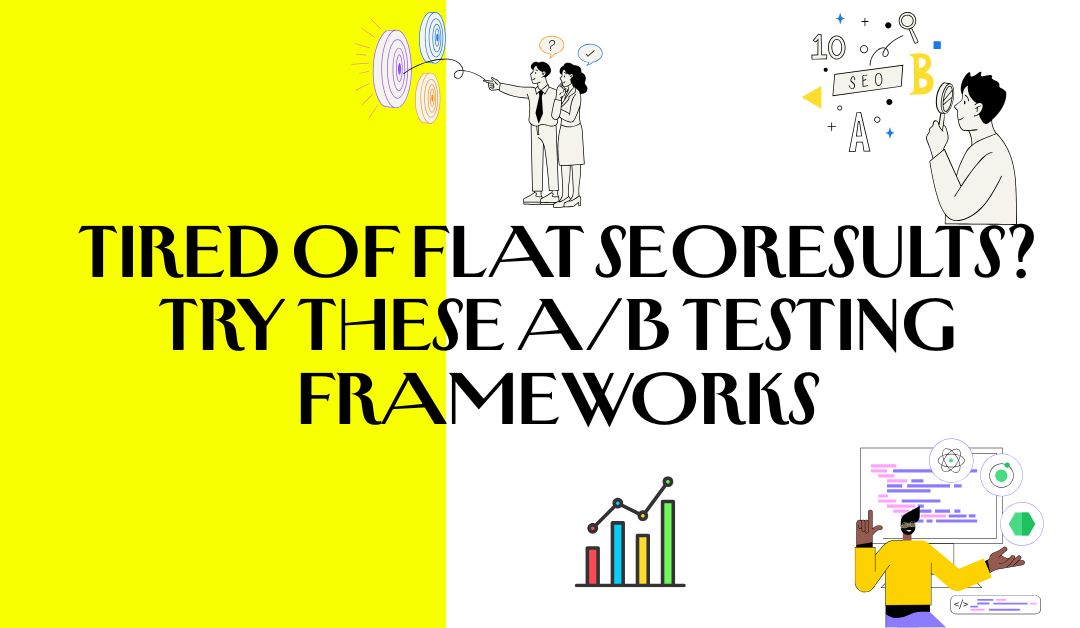Tired of Flat SEO Results? Try These A/B Testing Frameworks

Why Your SEO Feels Stuck
Imagine you plant a garden, water it every day, and watch the same tiny sprout that never grows into a flower. That’s what it’s like when your website ranks stay locked on page two or three of search results. You tweak your titles, add more keywords, or polish your meta descriptions, yet your traffic barely budges. It feels like you’re watering the same small plant over and over without seeing any growth.
To break out of that rut, you need more than guesswork—you need experiments that prove what works and what doesn’t. That’s where A/B testing frameworks come in. By comparing two versions of a page, headline, or call-to-action (CTA), you can watch real user behavior and choose the winning option.
SEO isn’t magic; it’s a science. If you’re doing business in the bustling market of SEO in Chennai, these frameworks will help you squeeze better results from each change you make. Whether you’re a beginner or someone with years of experience, A/B testing can turn vague hunches into clear data.
What Is A/B Testing and Why It Works
A/B testing is like a simple science experiment. You create two versions of something—let’s call them A and B—and show each to half of your visitors. Everything else stays the same: same page, same traffic source, same time of day. Then you measure which version gets more clicks, stays longer, or leads to more sign-ups.
Easy to set up. Many website builders and analytics tools include A/B testing features.
Data over opinions. Instead of guessing, you learn what people actually prefer.
Continuous improvement. Small wins add up to big gains in traffic, conversions, and revenue.
Even a tiny improvement—like a 2% higher click-through rate—can boost your visits by thousands over a year. That’s why brands from start-ups to global enterprises use A/B tests for everything from button colors to full landing pages.
Framework 1: Title and Meta Description Tests
Your page title and meta description show up in search results, and first impressions matter. A catchy title can double your click-through rate (CTR) without changing your ranking.
Identify a target page. Choose a page that ranks on page two or three—there’s room to grow.
Craft two headlines. Version A could be straightforward (“How to Bake Cookies”), while Version B adds a benefit (“How to Bake Cookies That Melt in Your Mouth”).
Write two meta descriptions. One might list features, while the other tells a quick story or asks a question.
Run the test. Use a tool like Google Optimize or your CMS’s built-in A/B feature.
Measure CTR and sessions. After enough traffic (usually a few thousand impressions), pick the winner.
Small tweaks can have big impact. Even changing “Tips” to “Secrets” or adding an emoji can catch the eye.
Framework 2: Content Structure Experiments
People skim articles. If your paragraphs are too long or your headings aren’t clear, readers bounce off. Testing content layout helps you keep visitors on the page longer.
Short vs. long paragraphs. Does breaking information into bite-sized chunks increase time on page?
Bullet lists vs. prose. Maybe your audience prefers quick lists they can scan.
Image placement. Does inserting a helpful screenshot halfway through keep people engaged?
Choose one element to test at a time so you know exactly what drives the change. For example, Version A might have a 600-word block of text, while Version B splits that into three shorter sections with subheads.
Framework 3: Call-to-Action (CTA) Trials
Even if you nail the content, a weak CTA means lost opportunities. Test different CTA texts, button colors, placement, and even the number of CTAs.
Button text. “Download Now” vs. “Get Your Free Guide”
Placement. Top of page only? Bottom of page? Both?
Design. Rounded button vs. square. Icon vs. text only.
Frequency. One CTA per page vs. multiple CTAs.
Track metrics like form submissions, downloads, or purchases. Over time, you’ll learn which CTAs convert best for your audience.
Framework 4: Internal Linking Patterns
Internal links help users navigate and spread “link juice” to boost page authority. But where and how you link can change user flow.
Version A: Links in the middle of paragraphs.
Version B: Links highlighted in a “Related Articles” box at the bottom.
Test which approach leads to more pageviews per session or lower bounce rates. You might discover that readers click more when links stand out in a box rather than blend into the text.
Framework 5: Speed and UX Focus
Page speed and usability are critical ranking factors. While you can’t A/B test raw load time as easily, you can test related elements:
Lazy loading images vs. standard loading. Does waiting to load below-the-fold images improve engagement?
Simplified navigation menu vs. full menu. Do fewer menu items keep visitors focused?
Sticky header vs. static header. Does a header that follows you down the page help or distract?
Measure metrics like bounce rate and session duration. The faster and smoother your site feels, the more Google rewards you—and the happier your visitors are.
Running a Full Testing Cycle
A/B testing isn’t a one-and-done task. Follow this cycle for continuous growth:
Audit: Identify low-performing pages with high impressions but low CTR or short session duration.
Hypothesis: Make an educated guess (e.g., “Adding an emoji to the title will boost CTR”).
Test Setup: Create Version A and Version B with only one variable changed.
Run the Test: Ensure your sample size is statistically significant (many A/B tools calculate this automatically).
Analyze Results: Look at primary metrics (CTR, bounce rate, conversions) and secondary metrics (time on page, pages per session).
Implement Winner: Roll out the better version to all visitors.
Repeat: Pick the next hypothesis and test again.
Over months and years, these small experiments compound into major improvements in traffic, engagement, and revenue.
Tips for Successful A/B Testing
Test one thing at a time. If you change too many elements, you won’t know which one made the difference.
Keep tests running long enough. A week or two is often not enough—aim for at least 2,000 visitors per variation.
Use reliable tools. Google Optimize, Optimizely, VWO, or your CMS’s built-in features make setup easier.
Document your tests. Track what you tested, why, and the outcome. This builds an internal library of proven tactics.
Prioritize high-impact pages. Focus on landing pages, product pages, and other high-traffic spots first.
Conclusion
Flat SEO results are frustrating, but they don’t have to last. By adopting structured A/B testing frameworks, you move from guessing to knowing. Each test—whether it’s a headline tweak, a CTA redesign, or a content layout change—gives you clear data on what resonates with your audience.
Remember, real improvements come from countless small wins. Start by testing one element on a high-traffic page, and build on your successes. Over time, you’ll create a powerful, data-driven SEO strategy that grows your traffic, boosts engagement, and converts visitors into customers.
Note: IndiBlogHub features both user-submitted and editorial content. We do not verify third-party contributions. Read our Disclaimer and Privacy Policyfor details.



